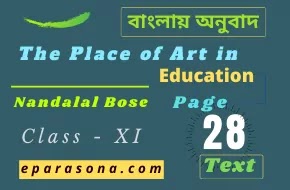The Place of Art in Education by Nandalal Bose | Textual Question and Answer | Full-Text Summary and Discussion in Bengali | বাংলায় অনুবাদ |
Nandalal Bose
About the Writer and Story ::
Nandalal Bose (1882-1966) studied art under the famous artist Abanindranath Tagore. Nandalal played a major role in shaping the modern face of Indian art. His famous works include the painting titled, Sati and Mahasweta. He sketched many of Rabindranath's works such as Chayanika and Gitanjali. He also illustrated Rabindranath's Sahaj Path.
In this extract taken from his notable work Drishti ar Shrishti (Vision and Creation), Nandalal attempts to revive the aesthetic sensibilities of his country. He discusses the importance of art education and measures that could be taken to implement the same.
লেখক এবং গল্প সম্পর্কে ::
নন্দলাল বসু (১৮৮২-১৯৬৬) বিখ্যাত শিল্পী অবনীন্দ্রনাথ ঠাকুরের অধীনে শিল্প অধ্যয়ন করেছিলেন। নন্দলাল ভারতীয় শিল্পের আধুনিক চেহারা গঠনে প্রধান ভূমিকা পালন করেছিলেন। তাঁর বিখ্যাত কাজের মধ্যে রয়েছে সতী ও মহাশ্বেতা শিরোনামের চিত্রকর্ম। তিনি রবীন্দ্রনাথের অনেক রচনা যেমন চয়নিকা এবং গীতাঞ্জলির নকশা করেছিলেন। তিনি রবীন্দ্রনাথের সহজ পাঠের চিত্রও তুলে ধরেছেন।
তার উল্লেখযোগ্য রচনা দৃষ্টি আর সৃষ্টি (দৃষ্টি ও সৃষ্টি) থেকে নেওয়া, এই নির্যাসটিতে নন্দলাল তার দেশের নান্দনিক সংবেদনশীলতাকে পুনরুজ্জীবিত করার চেষ্টা করেছেন। তিনি শিল্প শিক্ষার গুরুত্ব এবং এটি বাস্তবায়নের জন্য নেওয়া যেতে পারে এমন ব্যবস্থা নিয়ে আলোচনা করেন।
-: The Text :-
Page No - 28
Among those things that man has devised to acquire knowledge, or seek inner delight with, language has an important place.
মানুষ জ্ঞান অর্জনের জন্য বা আভ্যন্তরীণ আনন্দের জন্য যে জিনিসগুলি তৈরি করেছে, ভাষার একটি গুরুত্বপূর্ণ স্থান রয়েছে।
It is the vehicle for literature, science, and philosophy.
এটি সাহিত্য, বিজ্ঞান এবং দর্শনের বাহন।
Literature certainly provides man inner delight, but its field of expression is limited.
সাহিত্য অবশ্যই মানুষকে অভ্যন্তরীণ আনন্দ দেয়, কিন্তু এর প্রকাশের ক্ষেত্র সীমিত।
Art, music, dance, and the like make up for this.
তার সেই অভাব পূরণ করেছে শিল্প, সঙ্গীত, নৃত্য এবং অন্যান্য কলা।
They have their own specialities of expression as literature has its.
তাদের প্রকাশের নিজস্ব বিশেষত্ব আছে যেমন সাহিত্যের আছে।
Man apprehends the world with his mind and senses, derives aesthetic delight, and communicates this to others.
মানুষ তার মন এবং ইন্দ্রিয় দিয়ে জগৎকে বুঝিতে পারে, নান্দনিক আনন্দ লাভ করে এবং অন্যদের সাথে এটি যোগাযোগ স্থাপন করে।
Education in arts heightens man's knowledge and aesthetic experience and trains him in various modes of expression.
শিল্পকলার শিক্ষা মানুষের জ্ঞান এবং নান্দনিক অভিজ্ঞতাকে উচ্চতর করে এবং তাকে বিভিন্ন অভিব্যক্তির পদ্ধতিতে প্রশিক্ষণ দেয়।
This education in art, music and dance cannot be achieved through the medium of reading and writing, like the ear cannot do what the eye is meant to do.
শিল্প, সঙ্গীত ও নৃত্যের এই শিক্ষা অর্জন করা যায় না লেখা-পড়ার মাধ্যমে, যেমন চোখ যা করতে চায় কান তা করতে পারে না।
If the objective of our education is total development, art training should have the same status and importance as reading and writing.
আমাদের শিক্ষার উদ্দেশ্য যদি সার্বিক উন্নয়ন হয়, তাহলে শিল্প প্রশিক্ষণেরও পড়া ও লেখার মতোই মর্যাদা ও গুরুত্ব থাকা উচিত।
But the provision that our universities make for this is sorely inadequate at present.
কিন্তু আমাদের বিশ্ববিদ্যালয়গুলো এর জন্য যে ব্যবস্থা করে তা বর্তমানে খুবই স্বল্প।
It would seem that this is due to the general notion that art is the exclusive preserve of a few professionals and common people have nothing to do with it.
এটা মনে হয় যে এটি সাধারণ ধারণার কারণে যে শিল্প হল কিছু পেশাদারদের একচেটিয়া সংরক্ষণ এবং এর সাথে সাধারণ মানুষের কোন সম্পর্ক নেই।
When the educated do not feel any sense of shame at not understanding art, what question can there be of commoners?
শিক্ষিতরা যখন শিল্প বুঝতে না পেরে লজ্জাবোধ করে না, তখন সাধারণ মানুষের কী প্রশ্ন থাকতে পারে?
apprehends: knows (জানে)
aesthetic: relating to perception of beauty (সৌন্দর্যের উপলব্ধির সাথে সম্পর্কিত)
notion : general idea (সাধারণ ধারণা)
preserve : exclusive right (একচেটিয়া অধিকার)
To Read More >>
Do Practice this story, Textual Questions, and Answers yourself. You will definitely score an excellent result.
Subscribe to and regularly Visit this Website www.eparasona.com for getting more updates and keep in touch with this Online Knowledge Hub.
This is an educational tutorial Website. On this Website, we write blogs that help students to gain information about different subjects. So, everyone and of course all the students who want to enhance their knowledge must subscribe to this Website to keep in touch with this Online Knowledge Hub.









0 Comments